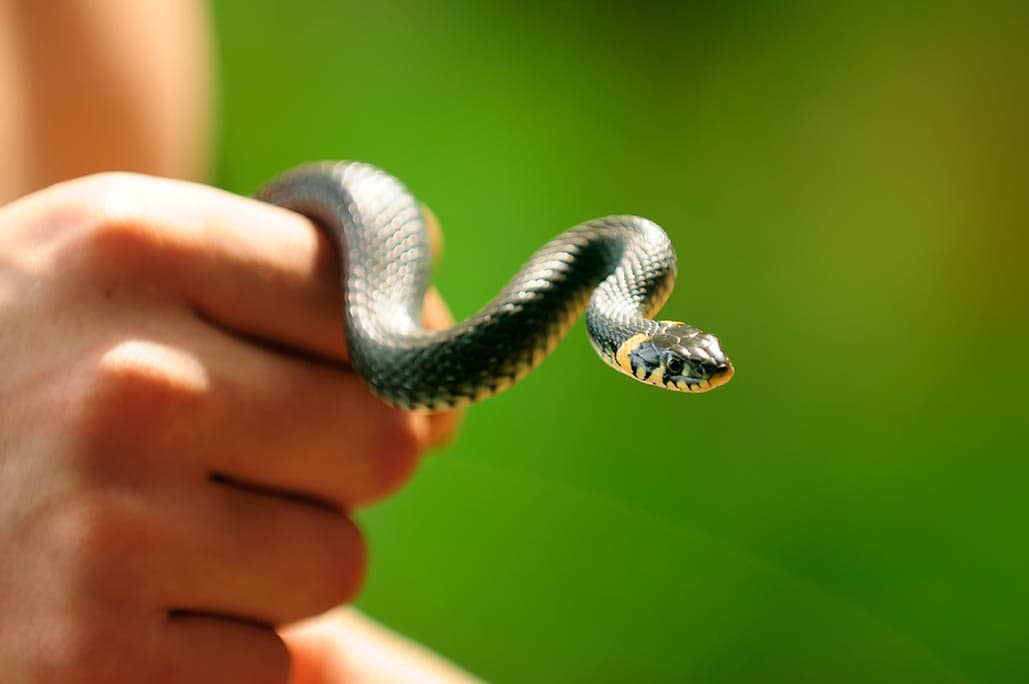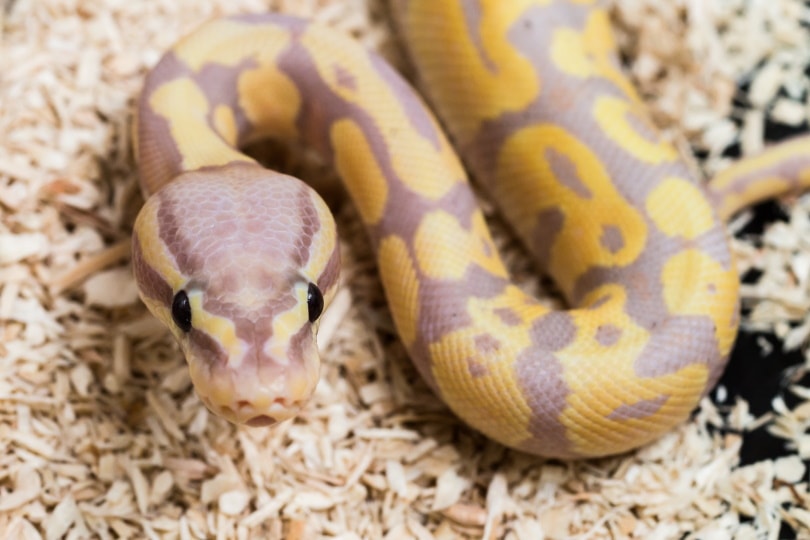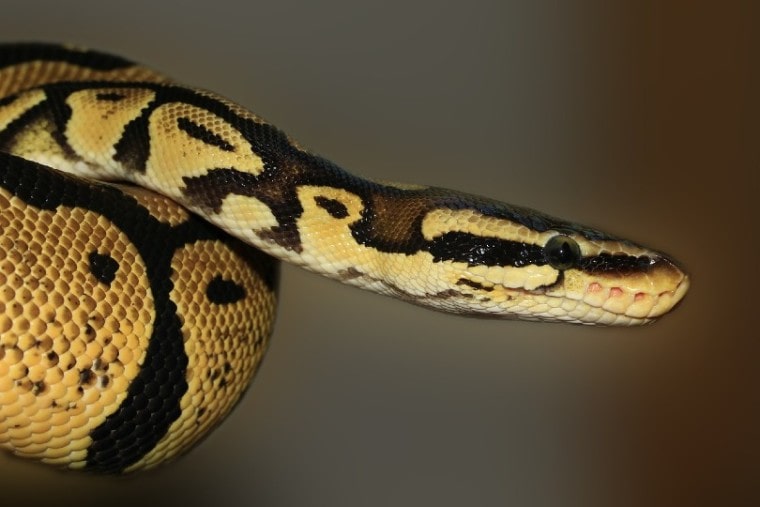
The ball python is native to the central and western parts of Africa. They naturally live in savannah and grassland habitats and spend a lot of their time burrowing underground. These snakes tend to come out at dusk and dawn and use their mouth to sense their prey. Although a ball python can seem like a scary pet, this species is fairly docile and gets used to their owners handling them. Of all the morphs to choose form, the Harlequin morph is one of the most common.
Quick Facts about Harlequin Ball Python Morph

| Species Name: | Python regius |
| Common Name: | Ball python |
| Care Level: | Moderate |
| Lifespan: | 20 – 30 years |
| Adult Size: | 4 – 5 feet long |
| Diet: | Small rodents |
| Minimum Tank Size: | 30 – 40 gallons |
| Temperature & Humidity: | 75°F – 90°F and 50% – 60% humidity |
Do Harlequin Ball Python Make Good Pets?
Harlequin ball pythons are one of the most popular pet snakes around the world. They make excellent beginner snakes because they don’t have a ton of demands and are fairly docile once they are used to their handler.
Appearance
Not all Harlequin morphs look the same, but the majority of them look exactly how you would imagine a regular ball python to look. The main difference is that the Harlequins have less yellow than normal pythons and are only partially striped. They have brown, black, and tan bodies with lighter underbellies. There are fewer spots and stripes and their bodies show a lot more of the tan coloring than the yellow that you’re used to seeing.
How to Take Care of Harlequin Ball Python
The habitat that your ball python lives in is the most crucial part of a healthy life. Without the right tank size, lighting, and heat, they could easily get sick and face a lot of health issues.
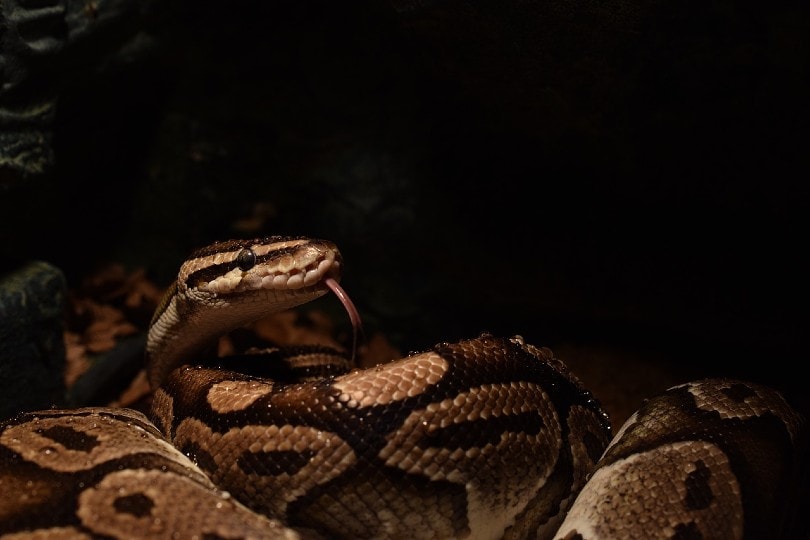
Habitat, Tank Conditions & Setup
Tank
The tank should be your first priority before you ever bring a python home. Give ball pythons a tank that is at least 30-40 gallons so that they can grow into it. Snakes tend to be escape artists, so make sure you have s sturdy cage and lid that won’t allow them to sneak out.
Lighting
Snakes do best when they have a lighting schedule that is 12 hours off and 12 hours on. They might like a couple of extra hours of sunlight during the summer months. Use a full spectrum lighting with UVA and UVB radiation to help them produce vitamin D3 and stimulate their behavior and mind.
Heating (Temperature & Humidity)
You never want it to be too cold in your cage. Try to create areas of different temperatures so that they can bask in one spot that is around 90°F and another for them to cool off, around 75°F. Improper heat in the cage could lead to issues with the snake’s metabolism, kidney, digestion, and immune system.
Humidity is another critical component. Ball pythons must have at least 50% to 70% humidity inside their vivarium at all times. Low humidity leads to difficulty shedding and dehydration, while too much humidity causes respiratory infections and skin diseases.

Substrate
Ball pythons like to burrow and have places to hid. If you want a low-maintenance enclosure, try using newspaper or butcher paper as the substrate. If you prefer something more decorative and lively, use a bioactive substrate like peat moss, shredded bark, or potting soil.
| Tank Recommendations | |
| Tank Type: | 40-gallon glass vivarium |
| Lighting: | Full spectrum lighting for 12 hours per day |
| Heating: | Heating pad |
| Best Substrate: | Newspaper, peat moss, shredded bark |
Feeding Your Harlequin Ball Python
Ball pythons are carnivores and consume their prey whole. Only feed them freshly killed or frozen prey since live animals could injure your snake by scratching or biting them. Feed your python once per week while they are adults. Older snakes over three years of age might only need to feed once every two to four weeks.
| Diet Summary | |
| Fruits: | 0% of diet |
| Insects: | 0% of diet |
| Meat: | 100% of diet – small sized rodents |
| Supplements Required: | None |
Keeping Your Harlequin Ball Python Healthy
Keeping your Harlequin ball python healthy is a matter of meeting their basic needs and keeping the cage clean and well-maintained. Try to give them a physical examination once or twice per year and always consult a veterinarian if you have any concerns with your snake’s behavior or health. Check their fecal matter for parasites if feeding them live pray, and keep an eye on the tank to make sure it is free from ticks or mites.
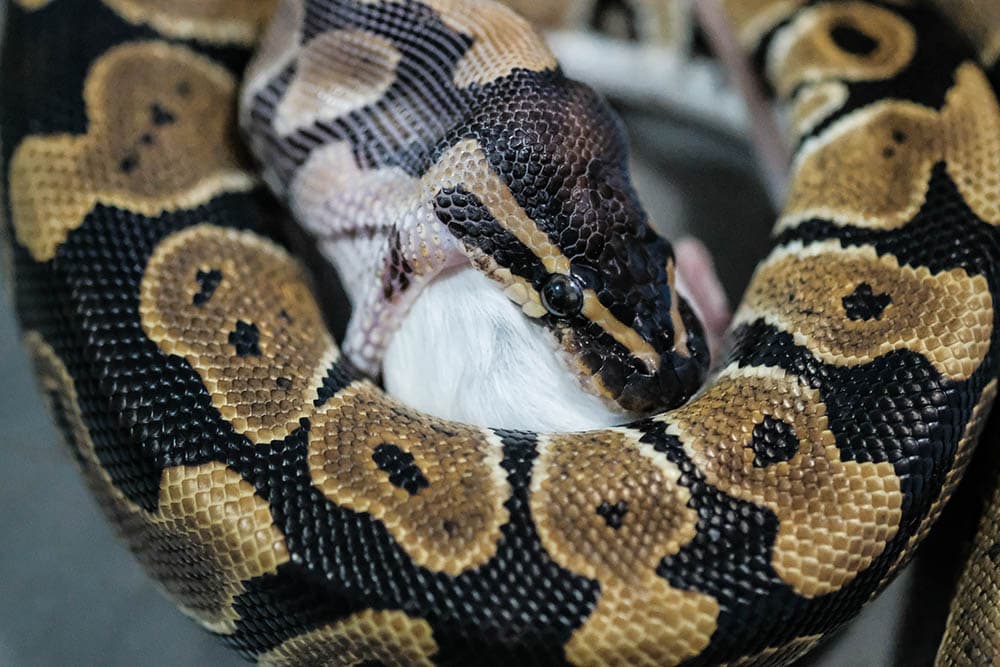
Common Health Issues
Breeding
Many people look forward to breeding their snakes because they want to expand their collections. Thankfully, these snakes breed well in captivity compared to some others. However, you have to have knowledge about the python’s behavior and genetics. The best time to breed your ball python is from November to mid-March. Only pair healthy adults together. Place a male and female together and wait for them to lock together. Once locked, do not disturb them until they separate on their own. Return the male to his enclosure and wait for several months to confirm the female lays eggs.
Shedding: What to Expect
Ball pythons regularly shed as they age and grow. Healthy snakes shed their skin in one whole piece, and their eyes might turn blue before doing so. If you are having difficulty, place the snake in a humidity chamber where the temperature is set to 85°F for one hour. Then return the snake to its enclosure.
How Much Do Harlequin Ball Python Cost?
Reptiles aren’t expensive pets. You are likely to find a Harlequin ball python for sale for anywhere from $100 to $300. This price could change depending on where you live and where you buy them from. Try to buy from shops that specialize in reptiles only. Some people prefer to buy them online. If you go this route, do some thorough research to guarantee that the breeder is reputable.
Care Guide Summary
Final Thoughts
If you’ve been considering bringing home a snake as a pet, there is no better species to start with than a Harlequin ball python. These simple creatures are happy with a clean and maintained environment and are one of the few snakes that have relaxed personalities. Once they are used to you, they’ll enjoy exploring more and being handled on occasion. Despite popular belief, snakes can make fun and interesting pets.
- What to read next: Paradox Ball Python Morph
Featured Image Credit: sipa, Pixabay




